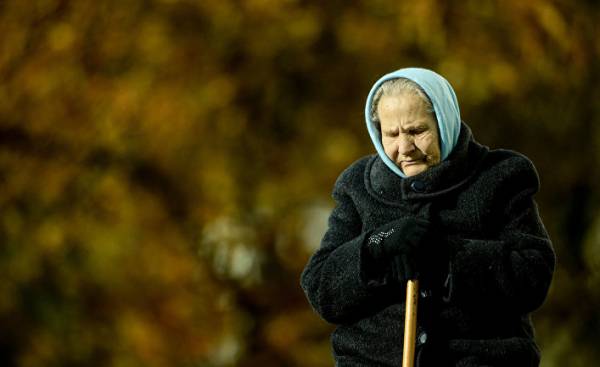
People have never lived as long as now. Of course, at all times, met the long — livers in the Bible, as we know, spoke of Methuselah, who allegedly lived for 969 years. But in most cases, until relatively recently, people for various reasons — because of diseases, wars and high infant mortality — was not likely to live to a ripe old age. The situation changed only about a hundred years ago. Since 1900, average life expectancy increased by about 30 years. reaching 71 years, and every ten years it increased by three and a half years. And the end of this unprecedented growth is not noticeable.
Women in Germany are now living an average of more than 83 years
Rapidly increasing the chances of an increasing number of people on the longevity describes the Berlin Institute of population and development in its own detailed study. According to him, Japanese women are rekordsmenka with an average life expectancy of 87 years. In Germany, a newborn boy can expect to live up 78.2 years, and the girl before is 83.1 years. And the upward trend continues. And even in the time of Emperor Wilhelm II, this figure was only 43 years.
In developing countries, life expectancy has been increasing recently, but now most of that growth in Africa and South-East Asia. However, the difference in life expectancy between Africa and the developed countries still large for 17 years, and the AIDS epidemic was discarded, for example, South Africa for a good ten years ago. However, in General, on the continent are now seeing the same development as in the developed countries a hundred years ago, the author writes, Sutterlin Sabina (Sabine Sütterlin). Thanks to better nutrition and better hygiene, clean water and access to medical science advances, Africans can no longer be afraid, for example, infectious diseases previously considered fatal. And hunger, natural disasters, wars and dangerous types of work carry in our time, much less lives than several decades ago.
Instead of epidemics and infections, people are threatening diseases associated with high levels of well-being
For many years the life expectancy of severely restricted high infant mortality. In Sweden in the late nineteenth century it was higher than it is now in Angola: of 1,000 children, more than 150 died in the first five years of life. In 2015 around the world until the fifth day of birth is also not lived 5,9 million people. However, this is two times less than in 1990. In Germany there is die only four babies out of a thousand. However, attracts attention increase in mortality in other age groups. Thus, the increasing life expectancy in our latitudes depends primarily on how long people live to old age.
In developed countries, according to the study, nine out of ten deaths were cancer and cardiovascular disease. On a global scale the most common cause of death of circulatory disorders and stroke. Only in poorer countries more people die from infectious diseases — pneumonia, diphtheria, HIV, tuberculosis and malaria. And only one death case eight falls on the fine dust or a poisoning with burning products. A significant risk of death from fires observed in South-East Asia and the Eastern Mediterranean.
Between Japan and Sierra Leone gaping chasm in 34 years
If we compare individual countries, ahead of the all — Japan, where residents on average reach the age of 83 years. And closes the list Sierra Leone, where people live on less than 34 years. Japan is followed by Switzerland, Singapore, Spain, Australia, Italy and Israel. But in European countries the situation varies: in the South and West of the continent people live to 82 years.
In Germany, the average life expectancy is 81 years, while in Russia the people in the middle don’t even live up to 70 years. In countries such as Ukraine, Belarus, Moldova and Russia are the lowest figures in Europe, and correspond to the level of Bangladesh or Guatemala. And in the US the difference in life expectancy in the most affluent and most deprived state is 20 years.
If you think about the reasons for these differences, it is easy to notice here is that in countries where lives a large number of rich people, life expectancy and more. In Germany this trend is not so obvious, but also present. For example, one study showed that, for example, in the district of Starnberg (Starnberg) in Bavaria, people live on average eight years longer than in Primesense (Primasens). And the Institute named Robert Koch figured out that men from disadvantaged social strata die ten years earlier than more affluent segments. Newborn boys of the poorest category of citizens live, according to researchers, the average of 70.1 years, and babies from the most affluent will reach an average of 80.9 years. In women these figures are respectively of 76.9 and 85.3 years.
The important role played by the health system
In Eastern Europe the life expectancy affect the consequences of social upheaval of the late Soviet era, the Director of the Berlin Institute Reiner, Klingholz (Reiner Klingholz). So, Russia still does not return to reach the level of 1970-ies and 1980-ies. Not the last role in the low life expectancy of men playing, according to him, their love for vodka and tobacco. More than half of deaths are caused by the effects of alcohol abuse.
What is the role of the system, can be traced on the example of a separated Germany. Until the 1970s years, the life expectancy in West and East Germany were virtually identical, says Klingholz. And then in the West there was the “cardiovascular revolution”: the cardiovascular diseases are treated better, and the difference in life expectancy began to grow rapidly. Only after the reunification of the country in the Eastern part the situation has improved.
However, a high level of health does not automatically mean longevity. So, Americans on average do not live longer than Cubans or Ricans, although the United States spends more on health care than anyone else in the world — as many as 17.1% of GDP, said Sutterlin. The top scorers of the Japanese, this figure is 10.2%. However, only 9% of health care costs in the US are covered by insurance companies or government programs. Those citizens who have to pay for the treatment out of pocket, go to doctors less frequently.
More importantly high social status and education
In the end, the life expectancy depends primarily on two factors: social status and level of education. They are interrelated and affect the level of income and professional status, housing quality, nutrition, attitude to risk. These are all important factors for a healthy and long life. For example, let’s look at Russia: men with a low education die on average 13 years earlier than men with higher education. The last “have much information about what style of behavior is useful and harmful”, says the report on the results of the study. And they have “more motivation in the correct use of these knowledge.”
A very illustrative example of Smoking, says Sutterlin. After the 1960-ies there was a proven relationship between pulmonary diseases and diseases of the cardiovascular system, on the one hand, and Smoking, on the other, “Smoking has become largely a symptom of less-educated and less-earning people”.
However, there is one exception: a tendency to obesity. Unlike developed countries, where this disease affects mainly the poor layers of society, in poorer countries, it is inherent in most well-educated citizens. Most illustrative of this trend in Pacific island States. There is fullness even became a kind of status attribute, according to the report. Diseases caused by obesity, there have three-quarters of all deaths. In Kiribati people on average die in 66 years — almost 16 years earlier than in New Zealand.
However, there is a problem in developing countries. With the growth of the urban population and level of prosperity, many people adopt “Western” eating habits, eat more meat and processed foods high in sugar and fat. From 1980 to 2015 the proportion of people with obesity has doubled in more than 70 countries, says a group of researchers in his article for the New England Journal of Medicine. Currently, 2.2 billion people worldwide are overweight or even obese, which is about 30% of the world population.
The price for a longer life can be more continuous years of disease
In Germany, where 21% of the population is older than 64 years, in turn, a real “boom” going through disease prevention and active lifestyle — at least among highly educated citizens. “70 is the new 60” is the slogan of experts to study the problems of the age. The largest number of older persons now live in Italy (22%) and Japan (26%). However, there is one thing: the price won extra years of life may be adding years of illness. Because the cost of a longer life can be a burden for the health systems of rich countries.
And rising life expectancy could have serious consequences for family structures, labour the world and society in General. Are you ready for the pension system of countries? Will not encounter young people with more problems in meeting their own needs? Will not tolerate if the collapse of the economic reform, faced with a growing number of elderly people?
Surveys show that for most people the main issue is not so much the maximum life span, and to a greater extent health until old age, autonomy and the absence of pain. The question of how we can grow old, from the point of view, in fact, demographic studies, it is not so interesting, says Mikko of Myrskyla (Mikko Mirskylä), Director of the max Planck Institute in Rostock. The main issue gradually becomes the following: how should we spend the years we will be able to “win”?







